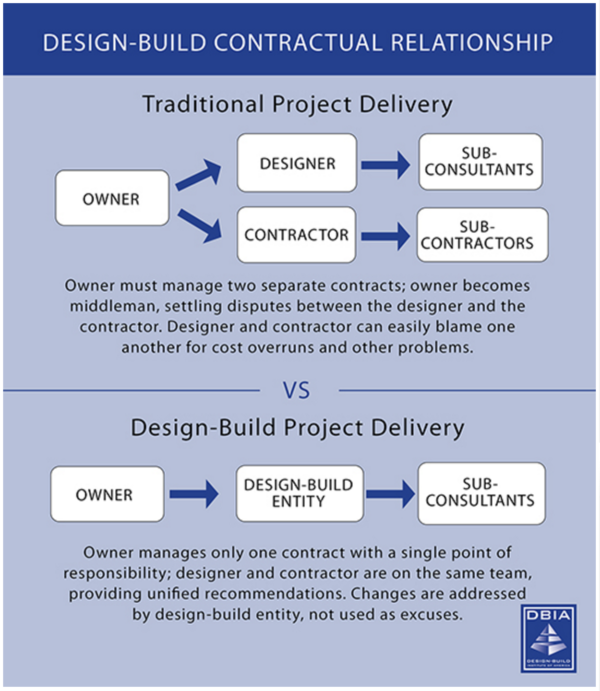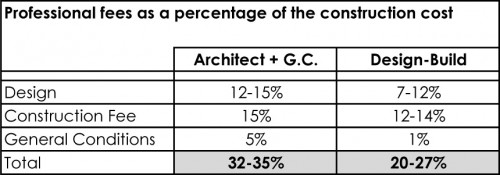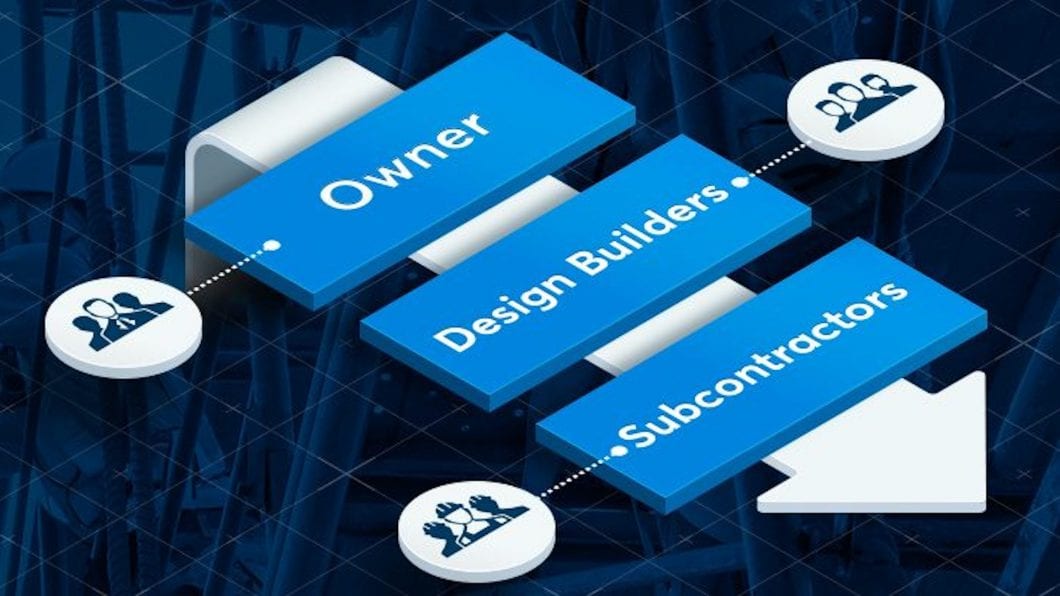10 Ways Design-Build Construction Helps Homeowners
If you’re a homeowner planning to hire a contractor, you should consider the advantages of design-build construction. Compared to the conventional architect and general contractor system, design-build can cut costs, increase transparency, and simplify communication. Keep reading to find out the top ten reasons why design-build construction helps homeowners succeed.
The New Standard for Home Construction
Previously thought of as the project “alternative method,” design-build is quickly becoming a project standard for delivery. In fact, according to Construction Dive, it’s expected that design-build will deliver almost half of U.S. projects by 2021. Construction spending in the assessed segments is anticipated to grow 18% from 2018 to 2021 and reach more than $320 billion. One of the reasons for its wide-spread adoption is favorable state legislation. “Last year, for example, Virginia legislators expanded design-build authority to all local governments,” explains Construction Dive. Plus, “the New York governor’s budget added new state entities to the list of those authorized to use design-build, and the Washington state legislature recommended design-build for construction of a bridge.” With the increase in state and local government backing, it’s no surprise that 43 states now have full or widely permitted authorization for public agency projects. As a result, it is quickly overtaking the old design-bid-build standard.
The Future of Construction
While design-bid-build is still the traditional model on construction projects, new numbers tell you all you need to know:
- Firstly, 82% of owner respondents said they’ve used or plan to use design-bid-build in the next five years. 58% of owners said they’ve used or plan to use design-build.
- Secondly, just over half of owners surveyed said design-bid-build usage would stay about the same over the next five years, while 32% predicted a decrease. Only 15% of owners predicted an increase in the use of the method.
- Lastly, 29% of owners said design-build adoption would stay the same, while 67% indicated increased utilization.
So what exactly is the difference between design-bid-build and its increasingly popular successor, design-build?
The Old Standard: Design-Bid-Build
In design-bid-build construction, the owner and architect work together to develop the project’s scope before it goes out to bid. Then, the general contractor, subcontractors, and material suppliers fulfill their individual roles. The general approach is somewhat set in stone before the project begins. When adjustments are needed, each subcontractor or must decide how best to do so within the budget. Even if they try their best, they often miss the mark on the most effective course corrections. The main problem: each contractor works in their self-interest. As a result, electricians don’t know what plumbers are doing, who don’t understand what the carpenters are doing, so forth. Worse still, none of them have this essential intel when the project scope changes.
How Does Design-Build Differ from Traditional Models?
In direct opposition to the bid-oriented approach, “Design-build is a method of project delivery in which one entity works under a single contract with the project owner to provide design and construction services,” explains the Design-Build Institute of America (DBIA).  As a homeowner, you can expect to see the following ten benefits of design-build construction.
As a homeowner, you can expect to see the following ten benefits of design-build construction.
1. Teamwork
We’re all in this together, and we all have the same goal –to arrive at a successful project that meets or exceeds the client’s expectations for their project. When challenges spring up on a project (and there are always challenges), pointing fingers is not an option. Everyone rolls up their sleeves and works on solutions.
2. Accountability
One entity is accountable for everything, including how the result looks, its costs, and its completion timeline. When the same group that designs the project also builds the project, there tends to be much more attention given to pricing and scheduling in the design phase. The cost of everything is apparent early on in the process – including all fees, construction costs, utilities, landscaping allowances, and more. Design-build focuses on results, not excuses.
3. Continuity
A design-build firm handles project management from start to finish, which adds efficiency. The chance for things to fall through the cracks dramatically diminishes.
4. Expertise
Design-build firms are experts in both fields. The principals should be licensed architects with formal architectural training and experience in the architecture field. They should also have professional construction and understand pricing, sequencing, and how buildings go together. In the new economy, we’re noticing architects trying a bit too hard to look like design-build operations without having any field training. There is a tremendous advantage to working with architects who can think like builders and builders who believe like architects. Still, design-build is a commitment, something you dedicate yourself to for an entire career –not just when it’s convenient.
5. Quality
We’ve all heard the stories that design and construction can get out of hand and messy. Design and construction shouldn’t be chaotic or stressful. A design-build firm is a beacon to clients throughout the process, guiding the way to the best possible outcome. Design-build refines a system from beginning to end and manages the chaos into orderly steps. 
6. Involvement
Design-build operates under the assumption that the client wants to be an active participant in the design and construction. By taking an involvement, they’re guaranteeing that they get the outcome and satisfaction of their goals – what they want will be achieved. We’ve found that such an involvement is inspiring and gives people a lasting sense of pride in their home.
7. Collaboration
Design-build construction cuts out the big egos so common in the design industry. With this method, the client retains total control over the project, and the team is there to empower them. Due to the nature of this construction, everyone is working for one common project goal. There’s a strong tendency for separate trades and teams to work on just what’s in their own best interest in a traditional design-bid-build model. This can lead to disconnection, miscommunication, and error. On the other hand, the design-build approach’s collaborative process utilizes and encourages teamwork, develops closer cooperation, stimulates information sharing, enhances transparent communication between project members, and improves the overall quality and project completion.
8. Transparency
Design-build is transparent because we want clients to understand the process and know what’s going on. The best partnerships work, not because people say what everyone wants to hear, but because they say what everyone needs to hear. Through clear communication, design-build firms define their budget early on, and it becomes the agreement for the entire project.
9. Time
Design and construction involve managing hundreds of timelines that need to coordinate in lockstep. Design-build creates opportunities for clients to sit with significant decisions, ask questions, and consider their options. Anything the team can do to avoid taking steps backward will lead to better, faster, and more cost-effective results. Homeowners can revisit major construction without change orders or additional fees.
10. Cost savings
Inherent to the design-build model is a savings of approximately 10% of the project costs. Here’s the quick overview:  The initial cost is always a critical factor in project delivery selection. Design-build has a total project budget established at the beginning of the project. Usually, this includes a fixed design fee and a tight implementation budget or a guaranteed maximum price (GMP). Installing an accurate account at the beginning of the project eliminates last-minute surprises. Research shows that alternative delivery methods provide a greater chance of meeting the initial budget than design-bid-build. While design-build might look like more money upfront, the cost savings in the long-run can be substantially more than other construction models.
The initial cost is always a critical factor in project delivery selection. Design-build has a total project budget established at the beginning of the project. Usually, this includes a fixed design fee and a tight implementation budget or a guaranteed maximum price (GMP). Installing an accurate account at the beginning of the project eliminates last-minute surprises. Research shows that alternative delivery methods provide a greater chance of meeting the initial budget than design-bid-build. While design-build might look like more money upfront, the cost savings in the long-run can be substantially more than other construction models.
The Right Design-Build Firm in Massachusetts
To maximize your space and enjoy your whole home remodel to its fullest, look for the right home remodeling team. Choose experienced professionals who will take the time to understand your lifestyle to get just the right feel and functionality. Your home is your biggest asset, so you deserve a trusted remodeling company that can provide the best quality and personal service. Woodland Builders is an excellent resource in the greater Boston area, providing top-level home remodeling services—on time and budget. Call us today! For more examples of our past work, follow us on Instagram @woodlandcontracting.

